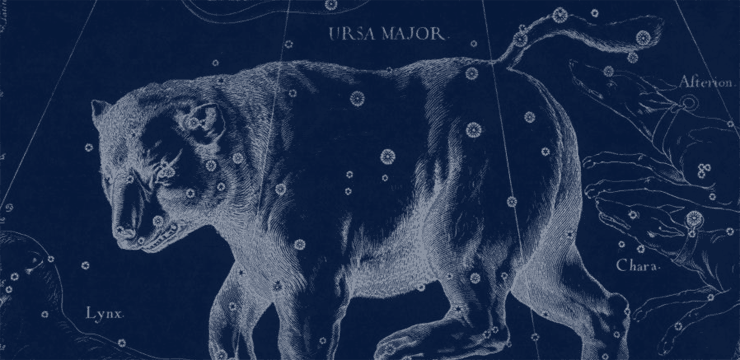November Constellations & Folklore
November 2011 :
After enjoying the overhead rescue of Andromeda by the prince charming Perseus, you might notice that Perseus has his foot on a tiny little clump of stars. At first glance, many people believe they have found the Little Dipper, not realizing that the Little Dipper is a part of our northern circumpolar sky, visible whenever you care to look in that direction; instead, that tiny cuplike group is the Pleiades. The Pleiades were seven sisters who were so beautiful they were placed in the sky to be adored forever; however, one of the sisters came back to Earth to marry a human being, so her light was extinguished. Looking at this tiny star cluster, the average person can make out only six stars, surprising, because all the myths about it concern seven who became six - for example, American Indian legends have seven hunters, one of whom came home empty-handed, or seven brothers who tried to jump up to the sky, with one being unsuccessful, or the Thai story of a mother hen and her six chicks (very sad) - yet this cluster is one that is astronomically very young, only several hundred million years old, too young for a star to have already been extinguished.
The Pleiades are sitting on the back of the Bull, Taurus. His face is very easy to see, as it is in the shape of a perfect letter "V." The upper-left star, you may notice, has a slightly reddish color. It is Aldebaran, Taurus's flaming red eye. From each side of the V going upward, you can see the size of the bull by the height of his horns. Slightly in front of, or to the east of, the head is his front legs, as he is galloping toward the rest of the winter constellations. His red eye is on target with the belt of the constellation that is the sign of winter, Orion, the Hunter.
Probably the most recognized sky picture, after the Big Dipper, Orion's three stars making up his belt is the centerpiece of the constellation. Directly below the belt is his knees, the brighter of the two stars Rigel, meaning "kneecap." Above the belt are his shoulders, with the brighter of those two having a ruddy tinge to it. This star is the infamous Betelgeuse, the translation of which is again the position in Orion, "giant's armpit." Below the belt, in a fairly good sky, you might be able to make out another, smaller line of what looks like three stars making up the position of Orion's sword. However, if you look at the center object, it will resolve itself into more than just star - you are looking at a giant star-forming region, the Great Orion Nebula, M42. The material making up this nebula is actually being lit by the stars that have formed from its dust and gas.
Following Orion's belt to the left, or east, you come upon the brightest star (but not brightest object) in the sky, Sirius, the star forming the nose of Canis Major, the Big Dog, one of Orion's hunting companions. His shape actually looks what he is, from his back down to his back legs and tail, to the front legs, and his ears flapping upward in the breeze as he's running after his master.
Sirius was a very important star to the early Egyptians, who noticed that when Sirius was first visible in the morning sky, that is, it's far enough away from the Sun that it can be seen for the first time - its heliacal rising - the Egyptians realized that the days were hot enough for the snows to melt from the mountains and run downward, joining with the waters of the Nile River, causing it to rise significantly to allow the farmers along the riverbank to create irrigation trenches to receive water naturally in their fields. It was also noted that just a day or two before Sirius's heliacal rising that another star, but not as bright as Sirius, had its rising just before Sirius. This became the indicator of Sirius, and was called Procyon, the star that rises "before the dog." It and only one dimmer star make up the outline of Canis Minor, the Little Dog. And, because these stars and dog constellations have their heliacal rising in the hottest time of year, the end of July and beginning of August, that time of year was named for the occurrence - The Dog Days.
When to Observe
Constellations
Related Topics




